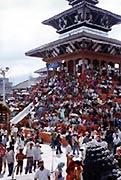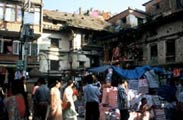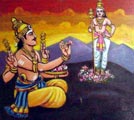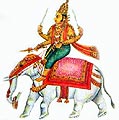|
Nepal's
Religious Festivals
|
|
 |
|
Nepal's
religious festivals |
|
Indra
Jatra: Indra Jatra and the display of Swet Bhairab |
 |
< Indrachowk
Every
evening people of all age-groups are seen hustling for the jaad and raksi
(traditional Newari liquor) oozing out from the thin traditional pipe of
the highly decorated mask of Bhairab in Hanumandhoka. |
|
Among
all the images of Bhairab taken out during the yearly festival of Indra
Jatra, Aakash Bhairab of Indrachowk and Swet Bhairab of Hanumandhoka are the most popular because of their elaborate decoration and huge size. |
|
 |
| Indra Jatra |
|
Another attractive element is the jaad and raksi dropped as prasad (blessing) from the mouths of the images.
There
is a tradition that from the first day of the festival , images of God
Bhairab (incarnation of Lord Shiva) and Indra (the Rain God) are displayed. The images are displayed on roadsides and intersections
in commemoration of the good deeds done by Rain God Indra.
 |
 |
 |
 |
| Indra
(the Rain God) |
Lord
Shiva |
Indra
(the Rain God) |
God
Bhairab
(incarnation
of Lord Shiva) |
 |
| From
the first day of the festival large crowds have come every evening for
the darshan (blessing) of God Bhairab and ask for prasad. In the Newar
community, Indra and Bhairab are considered to be one god with two appearances.
According to tradition, the image of Bhairab is brought out from each house
or temple for display during the festival. It is believed that by displaying
Indra and Bhairab, they are extending thanks to the Rain God for a good
harvest. |
|
The
most interesting part of the festival is the display of the image of Swet
Bhairab, which remains blocked from the view for the rest of the year.
There are no documents available. However, priest remeber that the tradition
is in practice from the very beginning of the festival from the Lichchhabi
period.
The scripture placed under the image tells that the image was made
during the reign of King Rana Bahadur Shah in 1852 BS. The rule of Rana
Bahadur Shah the periphery behind the temple was a deep (cremation ground).
And whenever the King came out of his palace, he used to come across the
cremation of dead person. Taking it as a bad omen, he used to return. To
stop the cremation process, he installed the image of Swet Bhairab just
in front of the main gate.
The legend also has it that people used to get
frightened of such a large mask so it is now closed throughout the year.
There is also a belief that Swet Bhairab wore precious jewellery so it
was protected by wooden curtains for security.
On
the eve of Indra Jatra the caretakers clean up the image and sacrifice
animals from one window among the nine closed windows to the beat of traditional
musical instruments. Great push-and-pull take place among the people to
get few drops of prasad (jaad) of Swet Bhairab and other displayed images
of gods. But they don't take prasad from Aakash Bhairab because there is
a tradition that all the jaad poured from the mouth of the image is sent
to Patal Lok (below the earth).
The
festival is celebrated among the traditional dance of Lakhe, Bhairab and
Devi and also the beats of traditional musical instrument is the attraction
of the festival, which is celebrated with full enthusiasm. Along with local
people, tourists are also seen enjoying the annual festival.
| 







